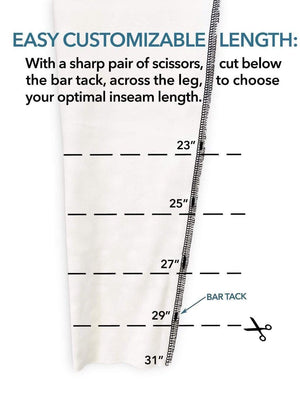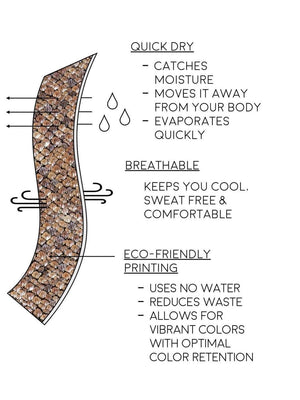Hey, we're Waterlust
We're in business to build a more sustainable world by bringing environmental science into your life in creative ways.















Educational resources & donation included with every purchase. Learn more.
Nurse sharks, Ginglymostoma cirratumknown, are known as the couch potato of the shark world. Up close, their skin appears as a stunning geometric mosaic of sand, copper and bronze tones. These diamond shaped structures are actually modified teeth, called dermal denticles. This tough exterior increases hydrodynamic efficiency and provides protection to sharks, though its shape and structure varies across species.
88% Repreve® RPET (recycled polyester made from post-consumer plastic bottles), 12% spandex
5% of sales will be donated to The Shark Research and Conservation Program (SRC) at the University of Miami to help fund important research focused on the ecology, movement and conservation of sharks.
Orders are lovingly packaged using eco-responsible materials and shipped from our HQ in Miami, FL within the same or next business day. We’ll email you with your tracking info as soon as your order is shipped.
Learn more about shipping, exchanges and returns here.
Tag us @waterlust to be featured
We lovingly prepare each one of our orders for its journey to you using the best packaging materials we can find with the least environmental impact.
Free within the U.S. International orders must pay return postage. Exchanges orders can be placed immediately with an instant credit.
We stand behind every product we make. If you have a problem, we will solve it with the relentless determination of a salmon swimming upstream to spawn.
Nurse sharks (Ginglymostoma cirratum) are globally classified by the International Union for Conservation of Nature (IUCN) as “Data Deficient”, with an unknown population trend, and thus, more research on their population size, distribution and trends, ecology, and threats is needed. Though they can grow up to 14 feet in length, they are slow-moving bottom-dwellers, inhabiting the warm, shallow waters of the western Atlantic and eastern Pacific oceans. Nurse sharks are particularly vulnerable to coastal fisheries and indirect coastal impacts from human activities, particularly in reef areas which constitute its main habitat.
Photo by Neil Hammerschlag
Nurse shark skin viewed up close. The diamond-shaped structures are actually modified teeth, called dermal denticles.
A nurse shark is fitted with an ID tag during a scientific workup by the SRC team.
Multiple research methods have shown that some species of sharks have declined in population by 90% or more during the last several decades in areas where they were formerly abundant. These declines are due to direct targeting in commercial fisheries, mostly for their fins and sometimes meat. Additionally, sharks are often caught unintentionally as bycatch in many other fisheries, caught and killed in some recreational fisheries (unlike catch and release), and may also be impacted by humans more indirectly through threats like habitat loss, pollution, and human-driven declines in the fish species sharks rely on for food.
Directed by Dr. Neil Hammerschlag, the Shark Research & Conservation Program (SRC) at the University of Miami conducts cutting-edge shark research while also inspiring scientific literacy and environmental ethic in youth through unique hands-on field research experiences.
Every year, SRC brings out thousands of people, mostly school-children, on their research boats to survey, sample, tag and study sharks. Opportunities are especially made available for under-served populations in the sciences.
SRC’s science focuses broadly on understanding the effects of environmental change on the behavioral ecology and conservation biology of sharks in a human‐altered world.
"We are so proud of our collaboration with Waterlust. Not only does their support help enable our shark conservation research, but the apparel itself is a walking billboard for marine conservation. It's an opportunity to start a conversation about the wonders and perils faced by sharks and how the average person can help make a difference.”
Neil Hammerschlag, Ph.D.
the Shark Research and Conservation Program at the University of Miami
These are very comfortable and the pockets make it all the better. I'm in love. (Waist: 34 in Hips: 40 in height: 5ft3)
I was a little skeptical about paying so much for a legging and bra set but they are amazing. I love this nurse shark pattern because it is a more neutral color and easier to combine. Perfect fit - I got the M top and leggings and I am about 132 lbs, 5'3'' tall, 38'' hips, 27'' waist. Fast shipping, but the minimum to get free shipping seems a little steep.
5’6”
34DD
8-10 dress
160 lbs
I order a Mighty (M) in leggings/bra/bodysuit and it’s perfect.
I think it’s safe to say I’m obsessed. This is my 3rd kit from Waterlust (I also have the blue fan coral bra/leggings and the eagle Ray bra/leggings/bodysuit). I work in apparel manufacturing, so I look at things through a very keen eye and everything I’ve received has been CONSISTENTLY great quality. The fabric has enough structure to hug you in without being restrictive, and it dries like lightning. I originally bought mine to wear diving—it offers great protection in warm water and I wear under both my shorty and full wetsuits—but I find myself wanting to wear the leggings all the time!
I have an hourglass shape overall, and body is curvy but athletic, and I find the cuts to be super flattering, too!
These are beautiful and fit well. Absolutely great patterns and for a good cause. Completely thrilled with them
The design is even better than the picture. Quality feels great. I can't wait to wear them.
Great fit, true to size and great quality - I got the small and usually wear a size 2-4
Purpose-Driven, Family-Run
Advocate for Marine Conservation
Donate to Research + Education
Eco-Responsible
Notify me when available
We will send you a notification as soon as this product is available again.
We don't share your email with anybody




